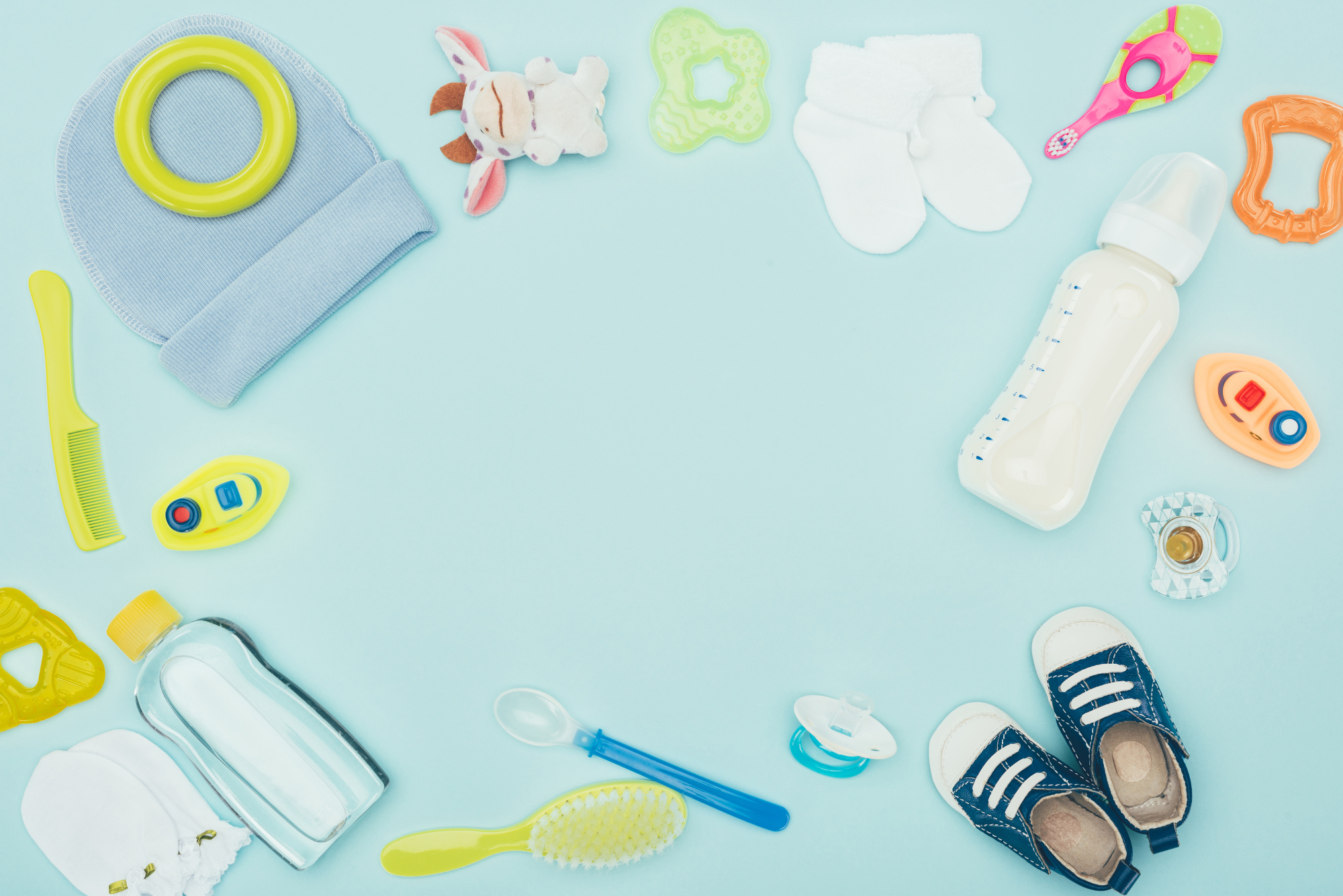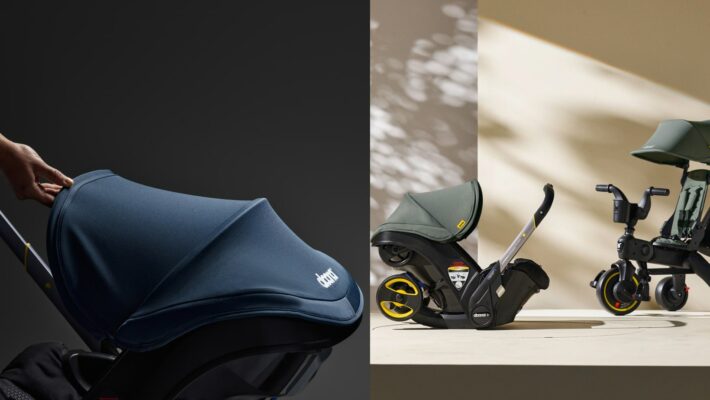Plastic serving dishes, toys, bottles, and teething rings can seem like a ubiquitous part of life with babies and toddlers. The material became popular because it is durable, lightweight, and versatile — but is it safe?
In the broader context of human history, plastic is a relatively new material. Although plastic has quickly established a pervasive presence in many parts of the world, scientists haven’t had a lot of time to study the long-term effects on human health and the environment. In light of how long it takes to conduct studies and observe health changes among participants, the impact of plastic on environmental and human health is not thoroughly understood yet. With that said, however, the emerging scientific consensus is that the consequences of continued plastic use could be catastrophic, both for human beings and ecosystems across the Earth.
There are several factors informing this perspective:
- Plastic is not biodegradable; it will take hundreds, if not thousands, of years to break down after it is discarded, and the majority of plastics are either not recyclable or not recycled.
- When it is discarded, plastic doesn’t rot. Instead, it breaks down to smaller and smaller pieces, eventually microparticles of dust. During this centuries-long process, toxic chemicals leach out into the nearby environment and contaminate soil and water.
- Micro-plastics and toxic chemicals are getting inside us even before we discard the plastics we use, and they’re making us sick. Chemicals and pieces of waste have also been found in wild animals, causing disease and even death.
In recent years, scientific research and media attention on specific chemicals from plastics have sent shockwaves through both health journals and the plastic industry. Before reports of hormone-mimicking chemicals and endocrine disruptors started being published, conventional thought on plastic products was that they were safe to use until proven otherwise. Now, a growing number of advocacy groups, doctor’s organizations, government agencies, and researchers are urging people to let go of the presumption of safety and instead assume that plastic products will leach chemicals until they can be proven to be safe.
Leaching Despite Labels
Even plastic products that are labeled “Dishwasher Safe” or “Microwave Safe” can leach a variety of chemicals into food and liquids — and that’s before they’re ever put under high heat. Sunlight alone can degrade plastic and cause it to release chemicals. Foods and beverages that are acidic — like orange juice or a simple tomato sauce — can actually result in more leaching. During laboratory testing of more than 450 plastic products sold at major retailers across the United States, the majority of the items tested leached chemicals before they were ever put under the stress of their intended uses. Worryingly, normal usage increased the rate of chemical migration significantly — especially into fatty foods, like meat, milk, and cheese.
Researchers at CertiChem — a testing lab founded by George Bittner, a researcher and professor of biology at the University of Texas in Austin — focused on plastic baby bottles and water bottles, including those marked as BPA-free, and found that all of them tested positive for leaching chemicals that mimic the hormone estrogen. Even when only holding water, BPA migrates out of polycarbonate bottles — and the rate increases with heat. Migration of BPA from epoxy-coated cans is another major problem, which is another good reason to get fresh or frozen produce instead of canned foods.
Exposure to some chemical leaching has been acknowledged for years, but skeptics dismissed the low dosages as too small to cause harm. More recent studies have shown that even in small amounts, repeated exposure to, and ingestion of, these chemicals can cause an array of potentially permanent health problems. This is especially true in children and during pregnancy, because little amounts of chemicals can have big impacts on little bodies — and several of the troubling chemicals that are being identified can breach the placental barrier.
Plastic Chemicals of Concern
In an extensive report on the health impacts of plastics that was published in February 2019, the Center for International and Environmental Law (CIEL) and its partners identified several chemicals to be cautious about, including the well-publicized BPA. Non-profit alliances like Healthy Babies Bright Futures and advocacy networks such as Upstream USA have been working to sound the alarm about the following chemicals related to plastics:
- BPA: bisphenol-A
- Perchlorate
- PFAS
- Phthalates
BPA, bisphenol-A
Bisphenol-A (BPA) is a chemical that makes plastic resins clear and tough. Of the harmful chemicals that can come out of plastics, BPA has received the majority of media attention so far. In 2012, the U.S. Food and Drug Administration (FDA) banned its use in products designed for children under 12 months of age — but they allowed it to remain in use in food packaging and other goods. There are many groups, including the Natural Resource Defense Council, who argue that limited ban didn’t go far enough, even while heralding the decision as a step in the right direction. The limited ban doesn’t preclude the use of BPA in all food packaging, which means it can still find its way into your diet or your little one’s. It’s even been found in off-the-shelf hair and skin care products — but it doesn’t necessarily stay there. Studies have found that it’s now common to find BPA in human blood and other tissues.
What does it do that’s causing so much distress? The short answer is: BPA is an endocrine disruptor that acts like estrogen and can seriously impact hormones, especially during the developmental stages before puberty. Disruptions in hormones can impact the growth and function of reproductive organs such as ovaries, prostate, and testes, and it can lead to chronic medical issues later in life — even acute, life-threatening conditions like cancer. In humans and other mammals, low concentrations of estrogenic chemicals are also linked to other physical and behavioral issues, which range from delayed growth and maturation to learning impairments and aggressive behavior.
In response to growing health concerns, manufacturers have been advertising BPA-free plastics as a safer alternative. What happens when a product goes “BPA-free” is: the manufacturer tends to swap in a chemical we know even less about, according to Dr. Russ Hauser, chair of the Department of Environmental Health and the Frederick Lee Hisaw Professor of Reproductive Physiology at the Harvard T.H. Chan School of Public Health. Unfortunately, testing has shown that even thermoset plastics made without BPA still leach chemicals that mimic estrogen. Clearly, cutting out BPA alone doesn’t necessarily solve the problem, especially since the chemical is still used in food packaging.
Banish Bisphenols
So, what can you do to reduce exposure for you and your family? Recycle the plastics you have and replace them with reusable materials that don’t leach chemicals, like glass or stainless steel. Glass is easy to sterilize, and there are shatter-resistant borosilicate glass products that are incredibly durable these days, though they can be pricey. For lighter-weight options, stainless steel is a great choice. Pura Stainless is on a mission to reduce plastic use and keep petroleum-based plastics out of the mouths of kids, so they have options for the whole family — from large bottles for the grown-ups, to sippy cups, and baby bottles. In fact, they’re the only MadeSafe certified bottle company of their kind at the moment, which means their products have been evaluated by a third-party nonprofit to ensure they are safe and chemical-free. They also offer insulated options for keeping contents warm or cool, and a variety of medical-grade silicone sleeves and accessories for a 100% plastic-free beverage container that doesn’t sacrifice convenience or comfort.
Perchlorate
Perchlorate is a plasticizer used in various formulations for food packaging, gasket closures, and as an antistatic agent in dry food packaging; however, it’s important to keep in mind that many chemicals used in food packaging also appear in many other consumer products too. Most people are exposed to them without their knowledge or consent, because ingredients lists do not include the materials used in the plastic components or packaging.
Essentially, perchlorate is a negatively charged molecule that is made by combining one chlorine atom and four oxygen atoms. It occurs naturally in the atmosphere, in some parts of the southwestern U.S., as well as in potash ore in the U.S. and Canada. It can also be manmade, and it has many uses as an industrial chemical. It’s found in a wide array of products, from bleach and containers to fireworks and even dry food processing equipment for cereals and spices. It has also been found in drinking water and in foods like bologna, salami, bagels, collard greens, and boxed mac ‘n’ cheese — a clear sign of chemical migration. In December 2016, the FDA published a report that found the amount of perchlorate in the diets of infants and toddlers increased 34% and 23% respectively when comparing data from 2008-2012 against earlier studies from 2005-2006, which is when the FDA approved its use in plastic and allowed it to be in contact with dry food.
Exposure to perchlorate can interfere with thyroid function, and pregnant women, their fetuses, and infants are at the highest risk of being negatively impacted by it. Hormones from the thyroid play a critical role in the growth and development of the brain and central nervous system in fetuses and infants, and a disruption can cause neurological disorders, impair memory, and can result in behavioral problems. In adults, normal thyroid function is important for regulating metabolism. Perchlorate can also inhibit iodide intake. Iodide deficiencies affect about 20% of pregnancies, and in those conditions, any exposure to perchlorate could pose a serious risk to the child’s healthy development, according to the Environmental Defense Fund. In conjunction with EarthJustice, the EDF has since filed a lawsuit to overturn the decision to allow perchlorate in food packaging and plastics.
Send Perchlorate Packing
Given that perchlorate is found in the environment, reducing your exposure is a more practical goal than trying to totally eliminate it from your life. Thankfully, there are a few ways you can minimize your risks of ingesting it. The most effective actions are to filter your water, swap bleach out for vinegar when disinfecting, and avoid dry processed foods and processed meats. Of course, you’ll also want to avoid purchasing more plastic items and avoid buying food products with gasket closures that pop when you open them, unless you know for sure that the gasket is made with natural rubber or a BPA-free silicone and not a polyurethane plastic.
Another thing to be cautious about are pre-washed vegetables and greens, because hydrochlorite bleach is often used to disinfect water and food preparation surfaces, and that can degrade into perchlorate over time and get into your foods. Plastic-wrapped or boxed veggies may seem cleaner than the open-air options you select yourself in the grocery store, but studies have shown they’re actually not. Not only are the washing chemicals a potential problem, but the plastic can leach chemicals into the contents inside. Additionally, the still air inside can cause some foods to spoil a lot faster by creating a stable environment for mold and other microorganisms that cause food-borne illnesses. That’s a whole lot of yuck! Whole foods you wash and prepare at home are the safest bet.
PFAS
PFAS refers to a group of per- and polyfluoroalkyl chemicals, including perfluorooctanoic acid (PFOA), perfluorooctane sulfonate (PFOS), and perfluoroalkyl acids (PFAAs). Recent studies have shown they are used in at least a third of fast food packaging, and they are often used to create a grease-proof barrier on paper food wraps, candy wrappers, and in microwave popcorn bags. They are also used in many household products, like water-resistant rain gear and fabrics, non-stick cookware, carpets, and upholstery. Sadly, they have also been linked to cancer, low birth weights, reproductive harm, and other diseases in humans and wildlife. Worse still, mothers can pass them on to little ones, both in the womb and through breastmilk. They are most dangerous to developing fetuses, and can cause neurological disorders and deficits that may become lifelong disabilities.
CIEL considers these chemicals to be among the world’s worst, describing them as “extremely persistent in the environment” because they accumulate in the food chain, take years to break down, and are widely distributed pollutant in soil, water, and air. In fact, the FDA recently took action to review PFAS chemicals as a result of rising global concern. Although that prompted the chemical industry to stop using some in food packaging, chemical producers have instead substituted other PFAS chemicals in their place despite the concerns of environmental toxicologists. The Stockholm Convention on Persistent Organic Pollutants is an international environmental treaty signed in 2001 which regulates PFOA and PFOS chemicals already. Currently, PFAS are under scrutiny by their scientific review committee.
At a recent meeting of that committee, they recommended against using any alternatives to PFAS “due to their persistency and mobility, as well as potential negative environmental health and socioeconomic impacts.” PFAS pollutants are particularly harmful to infants, children, women, the under-nourished, and those with compromised immune system function, like people who are sick or elderly. Ample medical evidence has linked them to kidney and testicular cancers, pregnancy complications, and thyroid problems.
Give PFAS a Pass
Now, this doesn’t mean you have to give up on fast snacks, to-go-containers, or popcorn completely. A stove-top pop takes just a couple of minutes, and you can keep leftovers fresh by using a plate to cover them in a bowl. Many grocery stores are also starting to offer bulk snacks and sweets that you can put into your own reusable, plastic-free containers and purchase by weight. Just keep in mind the kind of packaging your food comes into contact with, filter your water, and try to plan ahead if you need food to-go. Packing a snack in a reusable container is a great way to avoid fast food cravings when you’re out, and you can also use them to stash leftovers when you do go out to eat. There are many stainless steel and medical-grade silicone alternatives to disposable wrappers and snack bags that can help you avoid additional exposure in your diet when eating on-the-go.
Phthalates
Phthalates are another family of chemicals that make plastics soft and pliable, but still resistant to breaking. They’re used in hundreds of products and are often used in food packaging; however, CIEL’s report warns that many plasticizers — including phthalates — readily migrate into food and beverages. In fact, a study of school meals that was conducted before and after food packaging was allowed to include phthalates found concentrations increased by more than 100% as a result.
So, why the concern? Phthalates are endocrine disruptors that can cause harm to reproductive and nervous systems, especially in children — both in utero and after birth. Research has linked exposure to phthalates to deformities of the penis, as well as learning and behavioral issues. Studies have also shown that when there are higher levels of phthalates in a home, children are more likely to develop asthma and other respiratory conditions.
Between 2009 and 2010, the CDC conducted one of the most comprehensive surveys of the U.S. population’s chemical exposure. During that survey, researchers found 10 of the 15 phthalates they screened for in almost every urine sample they collected from the participants, which included children and adults. They also found BPA in 92% of the children’s samples, and that 51% of people tested also had PFAs and perchlorate in their system.
Seek Phthalate-Free Alternatives
According to the CDC, most people are exposed to phthalates by eating and drinking foods that have been in contact with plastic containers — so this is another good reason to recycle any plastic storage containers you’ve got and replace them with ceramics, glass, or stainless steel. To a lesser extent, it’s also possible to inhale phthalates or plastic nanoparticles, because they’re found in many household products — adhesives, vinyl flooring, lubricating oils, raincoats, and personal hygiene products such as shampoos, hair sprays, and nail polishes. They’ve also been found in some children’s toys, including inflatables. Nowadays, companies are starting to advertise that their packaging and components are phthalate-free. That can help make it easier to find replacements, and that’s really the only way to avoid increasing your phthalate exposure.
Safer Practices & Alternatives
By now, you might be ready to chuck every piece of plastic you can see — and honestly, eliminating as much as you can from your life is always going to be a good move. Recycle what you can — and do it as soon as you see a single scratch or any discoloration. However, even plastics marked as recyclable may not be processed by your local municipal recycling services. If that’s the case, you can do some research to seek out local drop-off centers or specialty recycling services that will accept your materials. If you don’t have a local option, TerraCycle has a national mail-in program for hard-to-recycle items — even some that were previously non-recyclable. Best of all, most of their programs are completely free, including shipping costs.
If you need to keep using plastics until you can get a replacement, make sure to keep them out of the microwave and dishwasher to avoid increasing their rate of chemical migration. Hand-washing in warm water with dish soap should be enough to keep them clean. That said, you’ll want to limit their use to room-temperature and cold storage, and choose a different material when you need to store acidic or salty foods.
If you must buy new plastics, try to seek out bioplastics or greenware, which are made of polylactic acid (PLA) that is derived from plants. If those are not available in your area, BabyGearLab — a pediatrician-founded product review page — recommends sticking to the safer plastics — Nos. 2, 4, 5, and some 7s. To find the number, search for the recycling symbol and it should be located in the center. When in doubt, however, the safest choice is to rotate it out.
Sources:
- https://www.babygearlab.com/expert-advice/are-plastics-safe-for-baby-bottles-and-sippy-cups
- https://www.ciel.org/reports/plastic-health-the-hidden-costs-of-a-plastic-planet-february-2019/
- https://www.aap.org/en-us/about-the-aap/aap-press-room/Pages/AAP-Says-Some-Common-Food-Additives-May-Pose-Health-Risks-to-Children.aspx
- https://pediatrics.aappublications.org/content/142/2/e20181408
- https://www.smithsonianmag.com/smart-news/study-finds-microplastics-more-90-percent-tested-water-bottles-2-180968507/
- https://www.theguardian.com/us-news/2019/may/28/plastics-toxic-america-chemicals-packaging
- https://www.npr.org/2011/03/02/134196209/study-most-plastics-leach-hormone-like-chemicals
- https://www.vox.com/science-and-health/2018/9/11/17614540/plastic-food-containers-contamination-health-risks
- https://www.ewg.org//research/ewg%E2%80%99s-guide-baby-safe-bottles-and-formula
- https://www.health.harvard.edu/staying-healthy/is-plastic-a-threat-to-your-health
- https://www.washingtonpost.com/lifestyle/plastic-metal-or-glass-whats-the-best-material-for-a-reusable-water-bottle/2019/09/25/5edcbe6c-d957-11e9-bfb1-849887369476_story.html
- https://www.discovermagazine.com/health/microplastics-are-everywhere-but-their-health-effects-on-humans-are-still
- https://www.nhm.ac.uk/discover/what-are-microplastics.html
- http://www.plastipure.com/wp-content/uploads/2015/02/2014Nov-Environ-Health-EA-in-BPA-Free-Resins.pdf
- https://www.atsdr.cdc.gov/pfas/pfas-exposure.html
- https://www.fda.gov/food/chemicals/perchlorate-questions-and-answers
- https://ntp.niehs.nih.gov/ntp/ohat/bisphenol/bisphenol.pdf
- https://www.edf.org/health/perchlorate-food
- http://blogs.edf.org/health/files/2017/11/EDF-Hypochlorite-Comments-Docket-No-EPA-HQ-OPP-2011-0667-FINAL-FULL-11-17-17.pdf
- https://www.ncbi.nlm.nih.gov/pmc/articles/PMC2647705/>
- https://www.niehs.nih.gov/health/materials/niehs_overview_508.pdf
- https://www.ncbi.nlm.nih.gov/pubmed/19407859
- https://www.sciencedirect.com/science/article/pii/S0160412018314594




